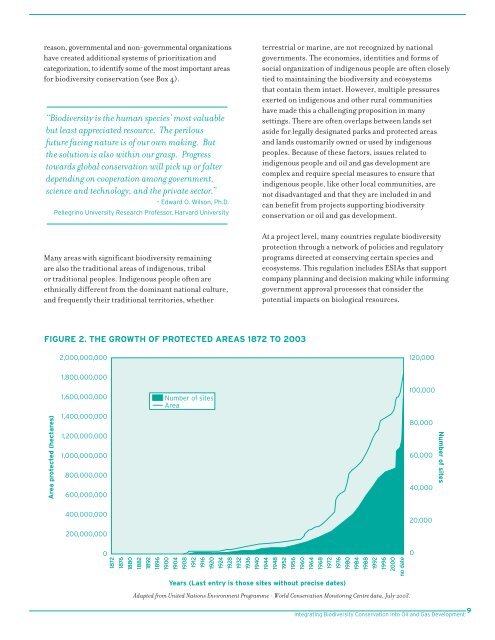Integrating Biodiversity Conservation into Oil and Gas ... - EBI
Integrating Biodiversity Conservation into Oil and Gas ... - EBI
Integrating Biodiversity Conservation into Oil and Gas ... - EBI
You also want an ePaper? Increase the reach of your titles
YUMPU automatically turns print PDFs into web optimized ePapers that Google loves.
eason, governmental <strong>and</strong> non-governmental organizations<br />
have created additional systems of prioritization <strong>and</strong><br />
categorization, to identify some of the most important areas<br />
for biodiversity conservation (see Box 4).<br />
“<strong>Biodiversity</strong> is the human species’ most valuable<br />
but least appreciated resource. The perilous<br />
future facing nature is of our own making. But<br />
the solution is also within our grasp. Progress<br />
towards global conservation will pick up or falter<br />
depending on cooperation among government,<br />
science <strong>and</strong> technology, <strong>and</strong> the private sector.”<br />
– Edward O. Wilson, Ph.D.<br />
Pellegrino University Research Professor, Harvard University<br />
Many areas with significant biodiversity remaining<br />
are also the traditional areas of indigenous, tribal<br />
or traditional peoples. Indigenous people often are<br />
ethnically different from the dominant national culture,<br />
<strong>and</strong> frequently their traditional territories, whether<br />
terrestrial or marine, are not recognized by national<br />
governments. The economies, identities <strong>and</strong> forms of<br />
social organization of indigenous people are often closely<br />
tied to maintaining the biodiversity <strong>and</strong> ecosystems<br />
that contain them intact. However, multiple pressures<br />
exerted on indigenous <strong>and</strong> other rural communities<br />
have made this a challenging proposition in many<br />
settings. There are often overlaps between l<strong>and</strong>s set<br />
aside for legally designated parks <strong>and</strong> protected areas<br />
<strong>and</strong> l<strong>and</strong>s customarily owned or used by indigenous<br />
peoples. Because of these factors, issues related to<br />
indigenous people <strong>and</strong> oil <strong>and</strong> gas development are<br />
complex <strong>and</strong> require special measures to ensure that<br />
indigenous people, like other local communities, are<br />
not disadvantaged <strong>and</strong> that they are included in <strong>and</strong><br />
can benefit from projects supporting biodiversity<br />
conservation or oil <strong>and</strong> gas development.<br />
At a project level, many countries regulate biodiversity<br />
protection through a network of policies <strong>and</strong> regulatory<br />
programs directed at conserving certain species <strong>and</strong><br />
ecosystems. This regulation includes ESIAs that support<br />
company planning <strong>and</strong> decision making while informing<br />
government approval processes that consider the<br />
potential impacts on biological resources.<br />
FIGURE 2. THE GROWTH OF PROTECTED AREAS 1872 TO 2003<br />
Protected Area Growth<br />
2,000,000,000<br />
120,000<br />
1,800,000,000<br />
Area protected (hectares)<br />
1,600,000,000<br />
1,400,000,000<br />
1,200,000,000<br />
1,000,000,000<br />
800,000,000<br />
600,000,000<br />
Number of sites<br />
Area<br />
100,000<br />
80,000<br />
60,000<br />
40,000<br />
Number of sites<br />
400,000,000<br />
20,000<br />
200,000,000<br />
0<br />
1872<br />
1876<br />
1880<br />
1882<br />
1892<br />
1896<br />
1900<br />
1904<br />
1908<br />
1912<br />
1916<br />
1920<br />
1924<br />
1928<br />
1932<br />
1936<br />
1940<br />
Years (Last entry is those sites without precise dates)<br />
1944<br />
1948<br />
Adapted from United Nations Environment Programme - World <strong>Conservation</strong> Monitoring Centre data, July 2003.<br />
1952<br />
1956<br />
1960<br />
1964<br />
1968<br />
1972<br />
1976<br />
1980<br />
1984<br />
1988<br />
1992<br />
1996<br />
9<br />
<strong>Integrating</strong> <strong>Biodiversity</strong> <strong>Conservation</strong> <strong>into</strong> <strong>Oil</strong> <strong>and</strong> <strong>Gas</strong> Development<br />
2000<br />
no date<br />
0
















![[PDF] Community Development Toolkit - CommDev](https://img.yumpu.com/48616495/1/184x260/pdf-community-development-toolkit-commdev.jpg?quality=85)
